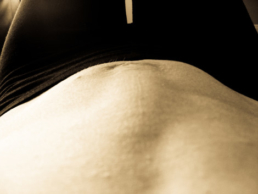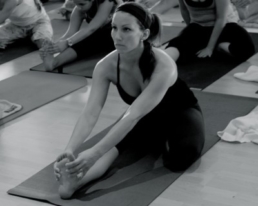Diastasis Recti: Restoring Your Core
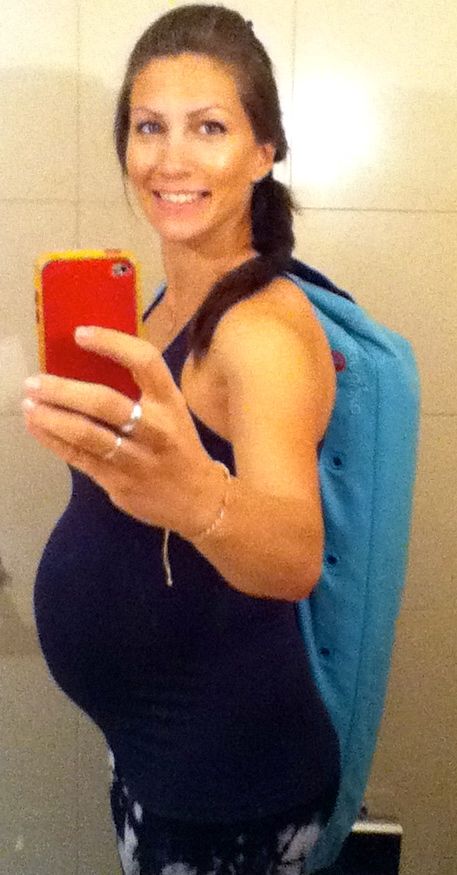
So many of you know now that I am a professional yoga instructor. Before this became my profession, physical activity had always played a major part of my life. I would run, strength train, take group fitness classes, participate in intramural sports and for the 5 years I lived in downtown Chicago, I walked nearly a mile to and from work daily.
My mother had pretty bad morning sickness with us kids so I sort of expected the same once I became pregnant. I was teaching yoga every day with my private clients and at the studio so in those early weeks, I would wake and wonder, "is this the day it will all change?" But that never happened thankfully. I continued to exercise but obviously modified where I needed to. I felt great and wanted to stay as strong and healthy as possible so my labor would be easier and my recovery would be quicker. We decided to keep quiet about our news for the first trimester and I didn't really start to show until about I was about 6 months along. Yes that is right, 6 months along. I know some of you are probably rolling your eyes in disgust at this but I was actually in a lot of pain. Once my belly started to expand, I could literally feel the fibers of my abdominals stretching out. This was really the only major discomfort I experienced but for about a week it was excruciating. I could barely eat, couldn't bend over (the weight of my belly was too much), couldn't breathe deeply and even wearing anything tight across my stomach was uncomfortable. The worst was sitting down as it put too much strain on my midsection. This was rather hard to avoid when relaxing on the couch or to eat dinner at the table or ride in the car, especially with the seatbelt on.
I specialize in pre and postnatal yoga so I was pretty sure I knew what was going on. It is called Diastasis Recti and basically it is when the connective tissues (the vertical linea alba) stretches sideways, leaving a separation of your outermost abdominal muscles. The job of these particular muscles is to be strong and support your back and organs. More on this later, but I knew most women experience this to some degree while pregnant as the hormone Relaxin is designed to soften the joints preparing our body for birth. But didn't want to exacerbate it and was very careful not to strain myself. When I first started to suspect this, I went to the doctor to see if he had any suggestions on how to relieve this vexation. He said it was indigestion and that I should eat bland food and take heartburn medication. Frustration just took over me as I knew this was not what was going on so I started to read as much as I could on this subject. As I said though within about a week this dimmed to a very dull pain and then eventually went away but there was, and still remains a tender spot right above my belly button. It was strange because I could even tell it was a bit hollow there. My hubby thought I was nuts but I felt, and could even see that something was different. I was intentional about my movements and posture for the next few months so as not to increase this separation.
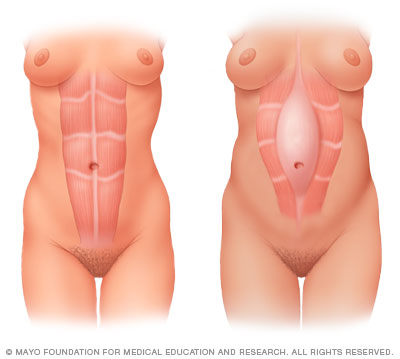
After having my son, I think I went through what every mom does and was just amazed at how the female body can do such superheroic acts. I initially felt as though I was unstoppable, part of that was probably the hormones and adrenaline:-) Then after a few days reality set in and I was brought back down to earth very quickly. I would get tired walking around for too long, stairs were winding me, my back was killing me (probably from carrying around my son and the constant breastfeeding) and I just felt lumpy. The physical discomfort was more annoying than disruptive and was fairly manageable with short walks, stretching and plenty of rest. Having not had full control over my core for the good portion of a year, I was left feeling very unstable and weak so I started to wear a Belly Bandit support band. These are AMAZING! If you are pregnant now, get one stat! They help to pull your core muscles back together and protect your back and organs. As I said above, I felt that I had Diastasis Recti (DR) to some degree fairly early on so I started wearing the larger of my 2 bands almost immediately after delivery and felt some relief while it was on. My physical aesthetics would change I knew so I just focused on my nutrition for the first few months of being home. I didn't worry about losing the baby weight for quite awhile. I was enjoying just resting, eating and being with my new family. When I had the ok to start exercising, I started this pretty slowly. The walks became longer, my yoga practice evolved and I slowly picked up the pace and frequency. I avoided doing any abdominal work at all and wore my support band as much as I could. Gradually I was able to transition into my smaller sized one. I measured my DR (video below) and went from nearly a 2.5 finger gap to a 2 finger gap within a month or so. Small victories but it was an improvement but not quite healed yet. I knew this as I could still see the small alien like bulge coming from my abdomen when I lifted my head or when I did planks... well it was more of a little ridge but not attractive! So I kept the band on and focused on my posture and concentrated healing exercises.
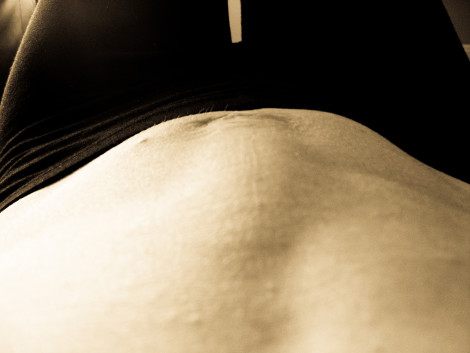
Surprisingly this doesn't only happen during pregnancy because we are all born with this space in our abdomen. Our nervous system develops quickly in the first few years of life and by about 3 years, this will fuse together however this doesn't always happen properly. Therefore some may be more prone to this later on because of how the abdominal wall weaves together and then if you add in pressures of weight gain, weak muscles and other factors, this could be a recipe for disaster with pregnancy or not. Don't be worried though as most of us can heal this with proper therapy and care. The majority of women want to jump right back into doing their (pre) baby workouts but this is the wrong approach to getting your fit and healthy body back if you are dealing with this. Your body and posture has changed so much during pregnancy leaving some muscles weak and overstretched, some extremely tight from months of compensation, and some that have been completely inactive.
Our first concern should be to work on using the diaphram and Transverse Abdominus (deep corset type) muscles while breathing. This can start right away in the hospital while laying in bed or as you start walking around. Take a quick look in the mirror or have someone snap a side angle photo of you, what does your posture look like now? In particular, how does your ribcage look? Are your lower ribs flaring out or are they drawn in causing your shoulders to round in a bit? Try to find a nice middle ground and gently pull the navel in as you breathe in and out feeling a slight contraction as you do so. This will slowly strengthen these deeply layered muscles and as you are gradually able to maintain this connection, you can start to focus on your alignment. While pregnant, our ribs expand and extend forward, this in conjunction with the weight of the growing belly, puts strain on your lower back causing the curves of the spine to change. Special attention should be given to our postural alignment as that alone will help guide and strengthen the muscles that have been dormant during this time.
Watch on YouTube: How to check for Diastasis Recti
https://youtu.be/yFnKN0TRSEg
For more in this video series and a step by step to the exercises below visit my YouTube channel for more
From there you can build to these isolated exercises:
- Transverse Abdominus holds with breath
- Pilates Knee-Ins keeping pelvis stable
- Heel Slides
- Cross Body Controlled Crunches with towel or resistance band
- Pelvic Tilts
- Modified Side Plank with belly hugs
Good luck ladies! But please remember you are recovering from a MAJOR phase in your life...MATERNITY and BIRTH. Take it slow and love yourself. You are worth it.
How to Handle the Binge Eating While Breastfeeding
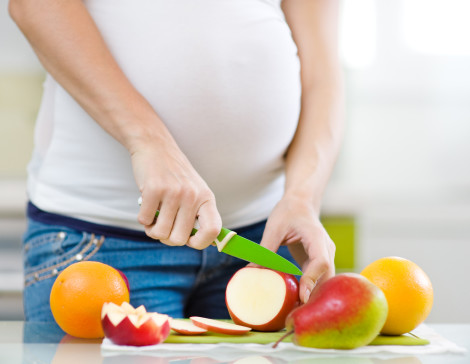
Those who know me, know I have always been a fairly hefty eater..."dieting" is not really my thing. I exercise a lot and eat healthy most of the day however if I want a sweet or some chips, I will have them and not stress about it. Moderation is the key to happy tummies in our house. If I know we have special dinner plans where dessert or drinks will be served, then I will just eat a salad or lighter lunch so I don't go overboard with my daily calorie intake. I would rather plan a bit to enjoy my meals instead of restricting myself at every turn or feel so guilty about my actions that I toss in the "daily towel" and throw back another handful of m&m's to make myself feel better....that can be a vicious cycle.
So I was completely at a loss when after having my son, I literally was annihilating everything in sight. There were days when I just was eating and eating and eating ALL DAY LONG! Like not leaving the couch sort of days. As I was exclusively breastfeeding, most of my time was spent either laying in bed or sitting on my butt with my little love. I loved this time and was focused on nourishing my body in the most wholesome way possible so my milk supply would be maximized. My amazing husband would bring me omelets, pancakes, oatmeal, bowls of pasta, burgers and even went so far as to have healthy snacks prepared for me in the fridge so when I did make it to the kitchen, I didn't have to do much. Here are some of my favorites...
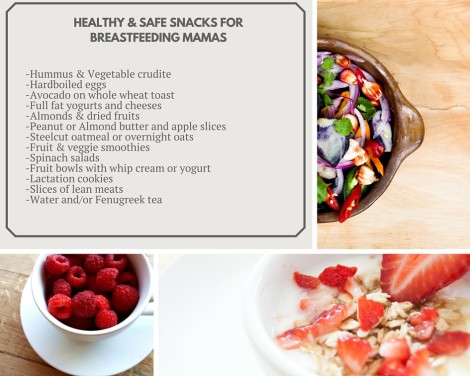
Many new mamas get fixated on lowering their daily calorie intake and/or also increasing their workout regemin tremendously so as to begin to lose the baby weight. If your plan is to breastfeed, it is imperative to stay within the range of 1800-2200 daily calories, more even if you are exercising or you may see a dwindling of your supply. This may even mean to consume 500 additional calories per day which can see a bit counterintuitive but vital. If you were like me, this really won't be much of a challenge as you literally won't stop eating. But that doesn't mean to grab the fast-food, savory snacks and desserts whenever you can. You want to fill that extra allotment with nutrient dense food that will fill you up, give you energy and stimulate lactation stores. The best way to do that is to eat a variety of foods including lean proteins, fruits, vegetables, whole grains, healthy fats, a prenatal vitamin and most importantly stay hydrated. Too much sugar, fat or salt in a diet could make your baby prone to obesity later in life. A 2007 study suggests that eating too many empty calories can impair a baby's ability to control it's appetite by overstimulating reward centers of the brain which promote junk food cravings as it matures. Let alone what the potential outcomes could be to your baby, eating processed or unhealthy foods are not good for a body that is recovering from such a stressful time. So mamas let go of the idea that we need to immediately get back into our pre baby jeans and enjoy being allowed to have some guiltless indulgence.
Why Staying Active In Pregnancy Is Essential
Pregnancy is a time to really relish your body, the miracle you are growing and take time to appreciate yourself. In many people's minds, that equates to sitting on the couch and relaxing...the whole 10 months! Well obviously you should find time for tranquility but you also should keep moving and preparing your body to be strong and healthy for labor and motherhood. This can include anything from gentle stretching, walking, yoga, pilates, swimming, to more high impact options such as hiking, jogging, cycling, provided your healthcare provider is ok with that. It is always imperative to get your doctors approval first should you have any pregnancy limitations and to rest when you feel your body is telling you to.
Here are a few benefits to continued fitness:
1.) Helps to keep the weight gain in check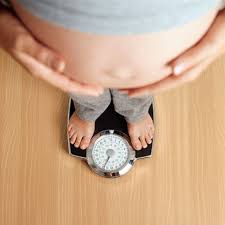
2.) Improves circulation throughout the body. This can have a beneficial impact on swollen ankles and hands, leg cramps, stagnant digestive system and much more.
3.) The endorphins from exercise (however intense) helps to combat the fatigue and emotional ups and downs you may experience.
4.) Movement will keep the joints lubricated and the muscles strong. This will help to ease any discomfort in the shoulders, back, hips and feet that will come as the body continues to evolve with the growing baby.
5.) Increased cardiovascular exercise helps to keep awareness of one's breath and lung capacity. Yoga specifically allows one to learn control of breath and helps with relaxation.
6.) Decreases chances of depression during pregnancy and after.
7.) A healthy, fit body is generally able to recover from birth much faster.
MY FAVORITE REASON...
8.) Most women who maintain some level of fitness tend to experience less medical intervention as well as shorter and less painful labors. Now is that motivation or what?
Keep in mind if you begin to notice anything that doesn't seem quite right, please listen to your body. If you have any of the following happen or even something not on this list, please check with your doctor right away. Every pregnant body is different and things do change on a daily basis so be mindful of where you are.
When to stop:
- uterine contractions
- vaginal bleeding
- excessive fatigue
- Fever over 100 degrees
- Upset stomach and/or vomiting (more than a few times in 1 hour)
- Sudden dizziness, faintness or intense headache
- Leaking of fluid from vagina
- Reduced fetal activity
- Sudden edema (swelling) or cramping of the calves
